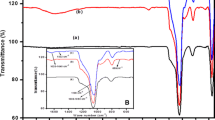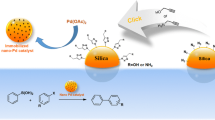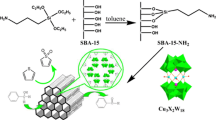Abstract
The immobilization of N,O-prolinate ruthenium benzylidene complexes as hybrid silicas is reported according to three routes: (i) co-condensation of a silylated precursor, 10, with TEOS via the sol–gel process (material M1); (ii) grafting of the same precursor on a preformed mesoporous silica M2 (material M3); entrapment of a parent non-silylated compound, 8, in the preformed mesoporous silica M2 (material M4). They have been characterized by several techniques. Solid state 29Si NMR measurements ensure the anchorage of the Ru-complexed prolinate fragment in the silica matrix of M1 and M3 by the presence of T and Q sites, while only Q sites are observed as expected for M4. Elemental analyses provide the N/Si ratios and TGA experiments give the weight loss of the organics during decomposition and hence indicating the amount of organics inserted in the materials. Adsorption–desorption analyses show that these solids had surface areas ranging from 310 to 620 m2g−1.These materials were tested as solid catalysts for two different reactions: ring-closing olefin metathesis and hydrosilylation of phenylacetylene with HSiEt3. Their recyclability has also been investigated. While M1 is the less active for the first reaction giving low conversions and selectivity compared to M3 and M4, it is by far the most efficient catalyst for the second reaction.







Similar content being viewed by others
References
Grubbs RH (2003) Handbook of metathesis, vol 1–3. Wiley-VCH, Weinheim
Vougioukalakis GC, Grubbs RH (2010) Ruthenium-based heterocyclic carbene-coordinated olefin metathesis catalysts. Chem Rev 110(3):1746–1787. doi:10.1021/cr9002424
Nolan SP, Clavier H (2010) Chemoselective olefin metathesis transformations mediated by ruthenium complexes. Chem Soc Rev 39(8):3305–3316. doi:10.1039/B912410C
Hoveyda AH, Gillingham DG, Van Veldhuizen JJ, Kataoka O, Garber SB, Kingsbury JS, Harrity JPA (2004) Ru complexes bearing bidentate carbenes: from innocent curiosity to uniquely effective catalysts for olefin metathesis. Org Biomol Chem 2(1):8–23. doi:10.1039/B311496C
Chauvin Y (2007) Olefin metathesis: the early days (Nobel Lecture 2005). Adv Synth Catal 349(1–2):27–33. doi:10.1002/adsc.200600522
Grubbs RH (2007) Olefin-metathesis catalysts for the preparation of molecules and materials (Nobel Lecture 2005). Adv Synth Catal 349(1–2):34–40. doi:10.1002/adsc.200600523
Schrock RR (2007) Multiple metal–carbon bonds for catalytic metathesis reactions (Nobel Lecture 2005). Adv Synth Catal 349(1–2):41–53. doi:10.1002/adsc.200600524
Samec JSM, Grubbs RH (2007) Bidentate N,O-prolinate ruthenium benzylidene catalyst highly active in RCM of disubstituted dienes. Chem Commun 27:2826–2828. doi:10.1039/B704821A
Samec JSM, Grubbs RH (2008) Ruthenium carbene complexes bearing an anionic carboxylate chelated to a hemilabile ligand. Chem Eur J 14(9):2686–2692. doi:10.1002/chem.200701495
Buchmeiser MR (2009) Polymer-supported well-defined metathesis catalysts. Chem Rev 109(2):303–321. doi:10.1021/cr800207n
Clavier H, Grela K, Kirschning A, Mauduit M, Nolan SP (2007) Sustainable concepts in olefin metathesis. Angew Chem Int Ed 46(36):6786–6801. doi:10.1002/anie.200605099
Copéret C, Basset J-M (2007) Strategies to immobilize well-defined olefin metathesis catalysts: supported homogeneous catalysis vs. surface organometallic chemistry. Adv Synth Catal 349(1–2):78–92. doi:10.1002/adsc.200600443
Zamboulis A, Moitra N, Moreau JJE, Cattoën X, Wong Chi Man M (2010) Hybrid materials: versatile matrices for supporting homogeneous catalysts. J Mater Chem 20(42):9322–9338. doi:10.1039/c000334d
Ciriminna R, Cara PD, Sciortino M, Pagliaro M (2011) Catalysis with doped sol-gel silicates. Adv Synth Catal 353(5):677–687. doi:10.1002/adsc.201000731
Elias X, Pleixats R, Wong Chi Man M (2008) Hybrid silica materials derived from Hoveyda-Grubbs ruthenium carbenes. Electronic effects of the nitro group on the activity and recyclability as diene and enyne metathesis catalysts. Tetrahedron 64(28):6770–6781. doi:10.1016/j.tet.2008.04.113
Elias X, Pleixats R, Wong Chi Man M, Moreau JJE (2007) Hybrid organic-inorganic materials derived from a monosilylated Hoveyda-type ligand as recyclable diene and enyne metathesis catalysts. Adv Synth Catal 349:1701–1713. doi:10.1002/adsc.200600627
Elias X, Pleixats R, Wong Chi Man M, Moreau JJE (2006) Hybrid-bridged silsesquioxane as recyclable metathesis catalyst derived from a bis-silylated Hoveyda-type ligand. Adv Synth Catal 348(6):751–762. doi:10.1002/adsc.200505447
Borja G, Pleixats R, Alibes R, Cattoën X, Wong Chi Man M (2010) Organic-inorganic hybrid silica material derived from a monosilylated Grubbs-Hoveyda ruthenium carbene as a recyclable metathesis catalyst. Molecules 15(8):5756–5767. doi:10.3390/molecules15085756
Monge-Marcet A, Pleixats R, Cattoën X, Wong Chi Man M (2011) Sol–gel immobilized Hoveyda-Grubbs complex through the NHC ligand: a recyclable metathesis catalyst. (Submitted)
Monge-Marcet A, Pleixats R, Cattoën X, Wong Chi Man M (2011) Imidazolium-derived organosilicas for catalytic applications. Catal Sci Technol. doi:10.1039/C1CY00287B
Alcaide B, Almendros P, Luna A (2009) Grubbs’ ruthenium-carbenes beyond the metathesis reaction: less conventional non-metathetic utility. Chem Rev 109(8):3817–3858. doi:10.1021/cr9001512
Menozzi C, Dalko PI, Cossy J (2005) Hydrosilylation of terminal alkynes with alkylidene ruthenium complexes and silanes. J Org Chem 70(26):10717–10719. doi:10.1021/jo051637+
Maifeld SV, Tran MN, Lee D (2005) Hydrosilylation of alkynes catalyzed by ruthenium carbene complexes. Tetrahedron Lett 46(1):105–108. doi:10.1016/j.tetlet.2004.11.025
Aricó CS, Cox LR (2004) Regio- and stereoselective hydrosilylation of terminal alkynes using Grubbs’ first-generation olefin-metathesis catalyst. Org Biomol Chem 2(18):2558–2562. doi:10.1039/B409832C
Gordillo Al, Forigua J, López-Mardomingo C, de Jesús E (2010) Stereoselective synthesis of (E)- and (Z)-triethoxy(vinyl-d2)silanes by hydrosilylation of acetylene-d2. Organometallics 30(2):352–355. doi:10.1021/om101127t
Zhang D, Yuan C (2008) An enantioselective nucleophilic addition of [alpha],[beta]-unsaturated trifluoromethylketones catalyzed by l-proline derivatives. Tetrahedron 64(10):2480–2488. doi:10.1016/j.tet.2007.12.035
Itagaki N, Kimura M, Sugahara T, Iwabuchi Y (2005) Organocatalytic entry to chiral bicyclo[3.n.1]alkanones via direct asymmetric intramolecular aldolization. Org Lett 7(19):4185–4188. doi:10.1021/ol051569d
Doyagüez EG, Calderón F, Sánchez F, Fernández-Mayoralas A (2007) Asymmetric aldol reaction catalyzed by a heterogenized proline on a mesoporous support. The role of the nature of solvents. J Org Chem 72(24):9353–9356. doi:10.1021/jo070992s
Hu JJ, Li FW, Hor TSA (2009) Novel Pt(II) mono- and biscarbene complexes: synthesis, structural characterization and application in hydrosilylation catalysis. Organometallics 28(4):1212–1220. doi:10.1021/om800978j
Lettow JS, Han YJ, Schmidt-Winkel P, Yang P, Zhao D, Stucky GD, Ying JY (2000) Hexagonal to mesocellular foam phase transition in polymer-templated mesoporous silicas. Langmuir 16(22):8291–8295. doi:10.1021/la000660h
Coquerel Y, Rodriguez J (2008) Microwave-assisted olefin metathesis. Eur J Org Chem 2008(7):1125–1132. doi:10.1002/ejoc.200700696
Acknowledgments
We acknowledge financial support from Ministerio de Ciencia e Innovación (MICINN) and Ministerio de Educación y Ciencia (MEC) of Spain (Project CTQ2009-07881/BQU and a grant to A. M.-M.), Consolider Ingenio 2010 (Project CSD2007-00006), Generalitat de Catalunya (Project SGR2009-01441) and the Agence Nationale de la Recherche (CP2D-MESORCAT).
Author information
Authors and Affiliations
Corresponding authors
Rights and permissions
About this article
Cite this article
Monge-Marcet, A., Pleixats, R., Cattoën, X. et al. Silica-immobilized N,O-prolinate ruthenium benzylidene complexes for catalytic applications. J Sol-Gel Sci Technol 65, 93–103 (2013). https://doi.org/10.1007/s10971-011-2610-9
Received:
Accepted:
Published:
Issue Date:
DOI: https://doi.org/10.1007/s10971-011-2610-9




